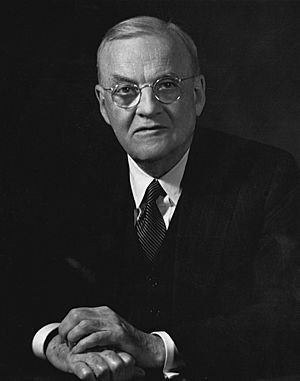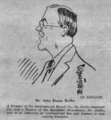John Foster Dulles facts for kids
Quick facts for kids
John Foster Dulles
|
|
|---|---|
 |
|
| 52nd United States Secretary of State | |
| In office January 26, 1953 – April 22, 1959 |
|
| President | Dwight D. Eisenhower |
| Preceded by | Dean Acheson |
| Succeeded by | Christian Herter |
| United States Senator from New York |
|
| In office July 7, 1949 – November 8, 1949 |
|
| Appointed by | Thomas E. Dewey |
| Preceded by | Robert F. Wagner |
| Succeeded by | Herbert H. Lehman |
| Personal details | |
| Born | February 25, 1888 Washington, D.C., U.S. |
| Died | May 24, 1959 (aged 71) Washington, D.C., U.S. |
| Resting place | Arlington National Cemetery |
| Political party | Republican |
| Spouse |
Janet Pomeroy Avery
(m. 1912) |
| Children | John W. F. Dulles Lillias Dulles Hinshaw Avery Cardinal Dulles |
| Relatives | Allen Welsh Dulles (brother) John Welsh Dulles (grandfather) Harriet Winslow (great-grandmother) Miron Winslow (great-grandfather) Dulles family |
| Education | Princeton University (BA) George Washington University (LLB) |
| Signature |  |
| Military service | |
| Allegiance | |
| Branch/service | |
| Rank | Major |
John Foster Dulles (born February 25, 1888 – died May 24, 1959) was an important American diplomat and lawyer. He was a member of the Republican Party. He is best known for serving as the United States Secretary of State under President Dwight D. Eisenhower from 1953 to 1959. Before that, he was briefly a U.S. Senator for New York in 1949.
Dulles played a big role during the early years of the Cold War. This was a time of tension between the United States and the Soviet Union. He strongly believed in fighting against communism around the world.
Contents
Early Life and Family Connections
John Foster Dulles was born in Washington, D.C.. His family had a long history of public service. His maternal grandfather, John W. Foster, had also been a Secretary of State. His uncle, Robert Lansing, held the same position. His younger brother, Allen Dulles, later became the head of the Central Intelligence Agency (CIA).
Dulles went to Princeton University and graduated in 1908. He then studied law at George Washington University Law School in Washington, D.C.
Starting His Career in Law and Government
After finishing law school, Dulles joined a law firm in New York City called Sullivan & Cromwell. He became an expert in international law. During World War I, he wanted to join the Army but couldn't because of his eyesight. Instead, he worked for the War Industries Board, helping with war efforts.
In 1919, President Woodrow Wilson chose Dulles to be a legal advisor for the United States at the Versailles Peace Conference. This meeting happened after World War I to decide on peace terms. Dulles also helped create the Dawes Plan. This plan aimed to help Germany pay back its war reparations (payments for damages).
During World War II, Dulles was involved in planning for peace after the war. He worked with the Federal Council of Churches to think about how to build a fair and lasting peace. He helped write a book called Six Pillars of Peace. This book suggested ideas for a new world organization.
Working with Political Leaders
Dulles was a well-known Republican. He was a close advisor to Thomas E. Dewey, who ran for president in 1944 and 1948. Dulles helped Dewey with his foreign policy ideas.
In 1945, Dulles helped write the beginning part of the United Nations Charter. This is the main document for the United Nations, an organization that tries to solve world problems peacefully. He also served as a delegate for the U.S. at the United Nations General Assembly several times.
In 1949, Dulles was appointed as a U.S. Senator for New York for a short time. He filled a vacant seat but lost the special election later that year.
Shaping Foreign Policy for the U.S.
Even though he was a Republican, President Harry S. Truman asked Dulles for advice. Dulles became a key person in creating the Treaty of San Francisco in 1952. This treaty officially ended World War II in Asia. He also helped create the U.S.–Japan Security Treaty. This treaty made Japan a strong ally of the U.S. during the Cold War. He also helped start the ANZUS security treaty between Australia, New Zealand, and the United States.
Secretary of State Under Eisenhower
When Dwight D. Eisenhower became president in 1953, he chose John Foster Dulles as his United States Secretary of State. This is the top diplomat for the United States. Dulles's time as Secretary of State was focused on dealing with communism around the world. He strongly believed that communism was a threat.
Dulles pushed for a strategy called "massive retaliation". This meant that the U.S. would respond very strongly, possibly with nuclear weapons, to any major attack from the Soviet Union. He also believed in "brinkmanship". This was the idea of getting very close to war without actually starting one, to show strength.
He worked to build and strengthen alliances against communism. One important alliance he supported was the North Atlantic Treaty Organization (NATO). He also created the Southeast Asia Treaty Organization (SEATO). This was an alliance between the U.S. and several countries in Southeast Asia to protect against communism.
Key Actions as Secretary of State
- Iran: In 1953, Dulles supported a plan by the Central Intelligence Agency (CIA) to help overthrow the Prime Minister of Iran. This action helped the Shah of Iran regain power.
- Vietnam: Dulles worked to reduce French influence in Vietnam. He supported the French in their fight against the Viet Minh, a communist group. After the French lost, he supported South Vietnam.
- Guatemala: In 1954, Dulles was involved in a CIA-backed military coup in Guatemala. The U.S. government believed that Guatemala's elected leader was leaning towards communism.
- Egypt: In 1956, Dulles opposed the invasion of the Suez Canal by Britain and France. Later, he became an opponent of Egypt's president, Gamal Abdel Nasser. This led to the Soviet Union gaining more influence in Egypt.
Later Life and Legacy
Dulles developed colon cancer. He resigned from his position as Secretary of State in April 1959 due to his declining health. He passed away on May 24, 1959, at the age of 71. He was buried at Arlington National Cemetery.
John Foster Dulles received the Medal of Freedom after his death. Many places were named in his honor. These include the Washington Dulles International Airport in Virginia. Schools in Texas and Ohio also carry his name. At Princeton University, where he studied, a part of the library is named the John Foster Dulles Library of Diplomatic History. It holds many important documents about American diplomacy.
Images for kids
-
Dulles with U.S. President Dwight D. Eisenhower in 1956.
See also
 In Spanish: John Foster Dulles para niños
In Spanish: John Foster Dulles para niños
- Vietnam War
- Brinkmanship
- New Look




